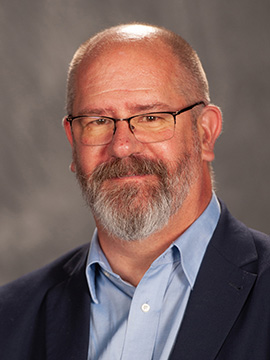Ross Peterson-Veatch

Vice President of Academics
Email president@hesston.edu
Phone 620-327-8231
Office Alliman Administration Center
Affiliated Departments or Programs
Education
- B.A., Earlham College (Richmond, Ind.)
- M.A., Indiana University (Bloomington)
- Ph.D., Indiana University (Bloomington)
In Addition …
Dr. Ross Peterson-Veatch has had a long tenure in higher education, starting as a Spanish instructor in 1989 and including over twenty years of administrative experience. After initially taking over as the vice president of academics at Hesston College, the board of directors invited him to step in as interim president in November 2023.
Dr. Peterson-Veatch started his career teaching Spanish at Earlham College (Richmond, Ind.) and went on to faculty appointments at Indiana University-Purdue University Indianapolis and at Goucher College (Towson, Md.). He served Indiana University Bloomington’s (IUB) Kelley School of Business as an instructional consultant focused on improvement of classroom teaching practice. He was also a faculty member at IUB in the liberal arts and management program.
Various administrative roles at Goshen (Ind.) College helped build Dr. Peterson-Veatch’s administrative resume. He served as associate dean and oversaw the general education program at Goshen including the first-year program, academic advising and the registrar's office. In addition to these roles, he was director of curriculum, teaching and faculty development at Goshen's Center for Intercultural Teaching and Learning. In that role he led the revision of general education, the creation of the first-year program and supported assessment and curriculum development for departments and faculty at Goshen. He also taught in the intercultural leadership master’s program at Goshen. He served as associate vice president for academic affairs and worked to add new adult and graduate programs to Goshen's curriculum, completing his time at Goshen as interim vice president for academic affairs and academic dean.
Before coming to Hesston in July 2023, Dr. Peterson-Veatch served as vice president for academic affairs and dean of the college, as well as professor of folklore at Southwestern College in Winfield, Kan.
A member of the American Conference of Academic Deans, Dr. Peterson-Veatch received their annual Excellence in Academic Leadership Award in 2021. He has been involved in college pedagogy initiatives since 1992 and served on the program committee for the 2009 Annual Meeting of the International Society for the Scholarship of Teaching and Learning. He is a lifetime member of the American Folklore Society and has served on program committees for the 2020 and 2022 annual meetings. He has held membership in the International Leadership Association, the International Society for the Scholarship of Teaching and Learning and the Professional and Organizational Development Network in Higher Education.
Dr. Peterson-Veatch received his bachelor’s degree from Earlham College (Richmond, Ind.) in Spanish and sociology/anthropology and holds master’s and doctoral degrees in folklore from Indiana University (Bloomington). He has published various articles and book chapters on academic administration and professional learning communities, and his academic interests include leadership studies, folklore, history of ethnography and colonial Latin American literature. He is an avid fly-fisherman, fly-tier and woodcarver, and when he is not playing guitar or mandolin, he loves to spend time canoeing and camping with his wife and two sons.

